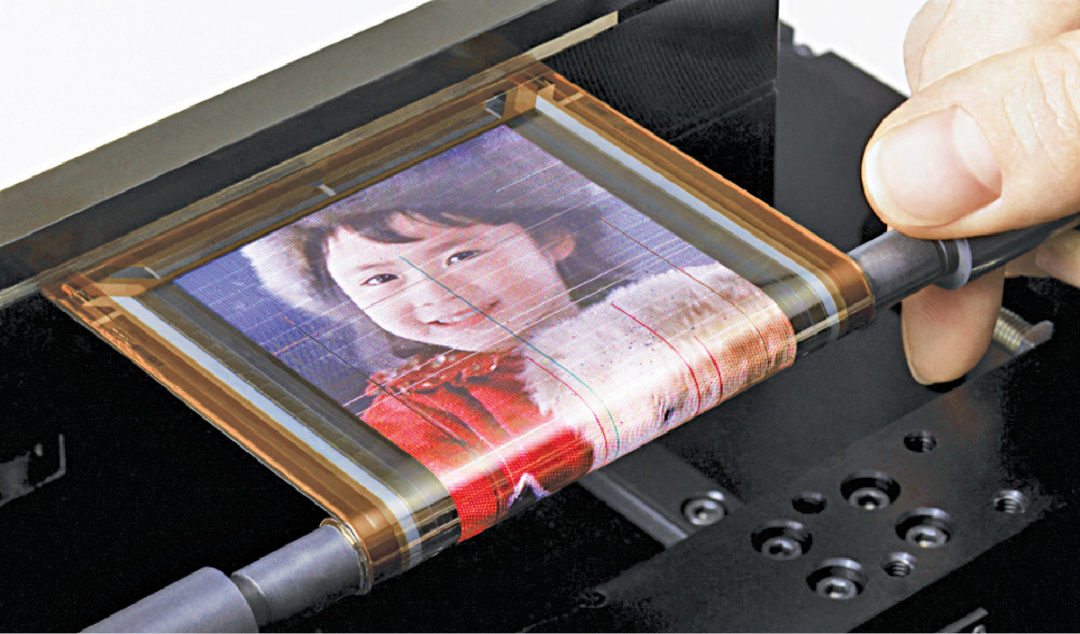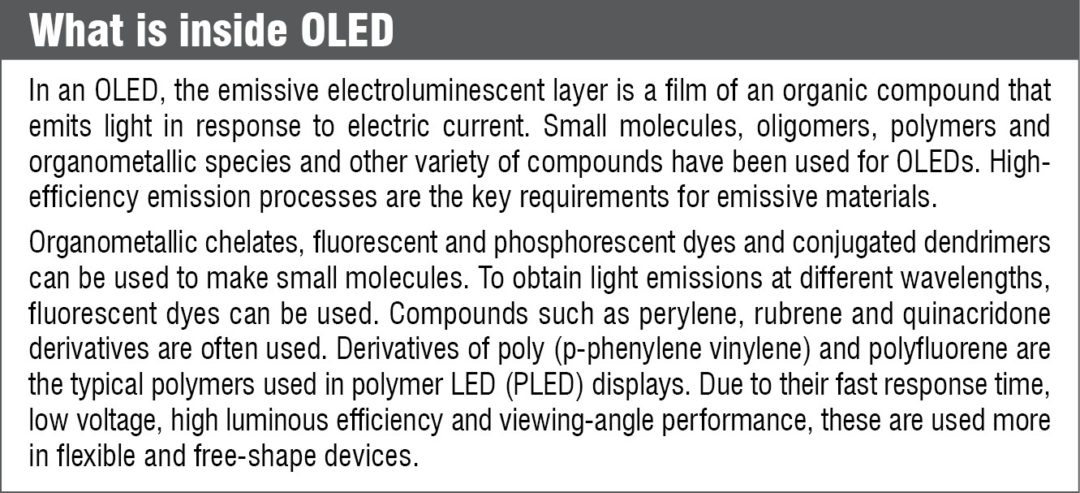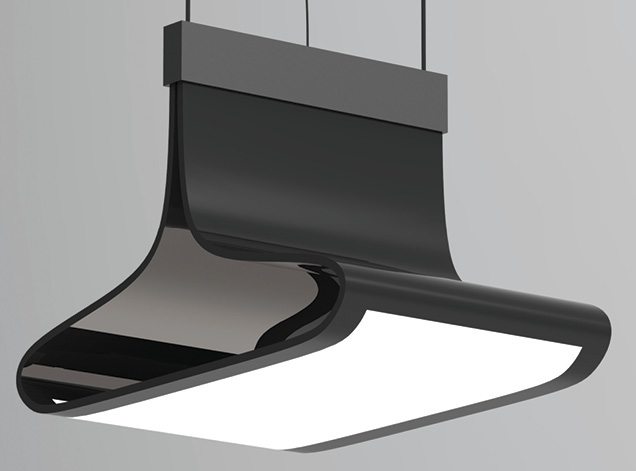Benefits of organic light emitting diodes (OLED) go beyond simple static image quality and the responsiveness and smoothness of the display itself. These are capable of refresh rates a 1000 times faster than standard LED-backlit liquid crystal display (LCD) panels. So these can easily catch a blur that might have been lost in traditional displays. But are we happy with such blazing-fast displays?
No, we definitely are not. Numerous researches are underway to further improve OLED efficiency and illumination at a lower cost. After all, a reduced price point sells. It helps boost displays for televisions, phones, tablets and more to an entire new level.
Like LCDs, OLEDs produce colour through green, red and blue sub-pixels on screen. However, there is a catch.
Blue emitters are hard to find
Organic molecules emitting blue light have been rare to find. Dr Mark Thompson, who is Ray R. Irani chair of chemistry, department of chemistry, chemical engineering and materials science, University of South California, USA, explains, “Blue phosphorescence remains a central challenge and has been so for the last ten years.”

Manufacturers have created organometallic molecules to overcome this problem. The problem here lies with expensive transition metals like iridium. These are used to enhance the molecule through phosphorescence, in order to improve efficiency. This solution, though expensive, does not produce stable blue colour.
Advanced matrix OLED (AMOLED) and super AMOLED has been one of the interesting application areas. Some of the best displays in the recent past have been the super-AMOLED ones like that of Samsung Galaxy Note 7.
Towards the new blue
Molecular Space Shuttle, a large-scale computer-driven screening process, was developed by a research team from Harvard University, USA, in collaboration with Massachusetts Institute of Technology, and Samsung. It identifies new OLED molecules that perform at par with industry standards through machine learning, cheminformatics, theoretical and experimental chemistry.
Kyulux, an advanced materials startup working in the field of OLED displays and lighting technology, has also announced securing Molecular Space Shuttle deep-learning system license for the discovery of materials for display and lighting applications. However, this process is more suited for finding dopants and not base materials.


An interdisciplinary team led by Dr Alan Aspuru-Guzik, professor of chemistry and chemical biology, Harvard University, has been working on replacing these organometallic systems with entirely organic molecules. Some algorithms were developed to compute the likelihood of efficient outcomes on a candidate pool of about 1.6 million. This helped prioritise molecules to be virtually tested and significantly reduce computational costs. Hopefully, these could help bring the prices down for hi-end devices like a MacBook Pro or Galaxy.
Successful reduction in the candidate pool.
Machine-learning tools have helped predict the colour and brightness of molecules using simple quantum chemical calculations. Finally, these were left with hundreds of blue molecules with performance improvement over organometallic molecules.
Harvard’s Office of Technology Development has a pending patent application on the molecules while they consider commercialisation opportunities. Further research in the field is expected to lead to molecules that could be used in flow batteries, solar cells, organic lasers and more.
Thompson says, “We are now looking at an approach that can capture high energy before the molecules disintegrate.” If we could stabilise reactive states, it could open up a lot of possibilities. Let us find out what is degrading the blue molecules, and what could possibly lead to some very interesting displays in the future.
TADF could hold another answer.
According to experts, thermally-activated delayed fluorescence (TADF) could solve the challenge of efficient and stable blue emission. Initial TADF devices, however, lost five per cent of their brightness in just 85 hours, which fuelled further research into the process.
Claims have been made regarding extending this time by eight times since then. In the newly-developed modification, two extremely thin (1nm to 3nm) layers of lithium-containing molecule, Liq, are placed on each side of the hole-blocking layer. This brings electrons to TADF material and prevents holes from leaving before contributing to emission.
A team led by Prof. Tae-Woo Lee, department of materials science and engineering, Pohang University of Science and Technology, South Korea, used pure organic TADF emitters that show very high internal quantum efficiency of nearly 100 per cent without precious metals. Easy synthesis due to use of pure organic molecules reduces synthesis cost. This is a big leap towards the development of inexpensive and solution-processed OLED displays and solid-state lighting.
Pinning together different refractive indices of titanium oxide and a conductive polymer, composite electrodes were developed by a collaboration of Korea Advanced Institute of Science and Technology, South Korea, and Pohang University of Science and Technology researchers. This increased the optical efficiency to about 1.5 times.
Usually, increasing the efficiency leads to a drop in flexibility. However, due to the involvement of a composite electrode, it endured strains four times stronger than convention. Even after 1000 bending cycles at a radius of curvature as small as 2.3mm, OLEDs remained intact and operational.
Achieving transparency and flexibility in OLED
Wearables and curved displays are seeing a lot of demand in the current market, creating a requirement for flexible displays. Graphene based OLEDs have reported the best efficiency and almost the same level as indium-tin-oxide based OLEDs.
Graphene as a highly-flexible light source promises to be a key element in next-generation displays and lighting. Current flexible solutions involve graphene based OLEDs, which use graphene as a transparent electrode placed between titanium-dioxide and conducting polymer layers. Efficiency and effective reflectance of transparent electrodes is increased in optical designs, which is due to the synergistic collaboration between high-n and low-n layers.
If all goes well, we could very well see foldable smartphones from Samsung employing flexible OLEDs as early as next year. Lenovo showed off a phone and tablet at its tech world convention in San Francisco, USA, this year. Youtubers prototyping the device can be seen wrapping these around their wrists.
Involvement of ceramics has been a more recent development. Dutch R&D institute, Holst Centre, in collaboration with American ultra-thin ceramics supplier, ENrG Inc., has designed and developed a flexible OLED that promises a ten-year-plus lifetime. The 12cm x 2.5cm prototype offers an intrinsic barrier to protect OLEDs from the environment.
Most flexible OLEDs require a multilayer barrier on both sides. However, researchers have solved this problem with just the ceramic thin e-strate and a thin-film top encapsulation. Plasma-enhanced chemical vapour deposition was used to print a few layers as well.
Minimising the losses
The problem with majority of LEDs is the high amount of losses. The high-efficiency spectrum of LEDs falls at about 50 per cent. So with the best of LEDs we still have a loss of 50 per cent through heat. A new OLED deposition process based on finite-element method has been developed by Korean equipment maker Dawonis. This can be scaled to large-area deposition, enabling efficient evaporation based OLED TV production.
In OLEDs, around 40 per cent of the total emitted light ends up coupling to surface plasmons at the metal cathode. A nanostructured or nanograting cathode structure into their OLED design could theoretically reduce plasmon loss. Using simulation, researchers at Konica Minolta Laboratory, Japan, have designed a simple model representing a metal and emitting layer structure. Optical effects resulting from arbitrary sub wavelength structures were simulated using finite-element model. Conclusions suggest that using a nanostructured cathode could help significantly reduce plasmon loss.
What do we have here? A blue light emitter, perhaps
Recently, a group of Japanese researchers found a family of twisted organic molecules that could emit blue light. Prof. Takuma Yasuda, advanced electronics materials research division, and his team at Kyushu University, Japan, has developed more efficient, cheaper and stable organometallic molecules for use in OLEDs.

They have used twisted pyrimidine-acridan-derived compounds to produce brilliant blue glow. The tricky bit is that, one part of the molecule is orthogonal to the other. Changing the substituent at pyrimidine unit in these emitters can finely tune their emissive characteristics, thermal properties and energy gaps between the singlet and triplet states, while maintaining frontier molecular orbital levels and, thereby, optimising their optoelectronic properties.
Biomedical application areas
Apart from OLEDs being used for phones and lamps, applications for OLEDs are very vast, ranging from curved OLED displays that are placed on non-flat surfaces to transparent ones embedded in car windshields and window panes.
UK based PolyPhotonix, in collaboration with Centre for Process Innovation, has developed a wearable blanket. It uses printed OLED lighting to administer phototherapy for possible treatment of a number of skin conditions such as acne, psoriasis, eczema and jaundice. The blanket could also be used for wound healing and anti-inflammatory treatments.
Advanced VR headsets could also drive demands for higher-end OLED displays.
Researchers at University of Tokyo, Japan, have developed an ultra-thin and flexible protective layer to create an air-stable OLED display. This is expected to enable creation of electronic skin (e-skin) displays of blood oxygen meters, e-skin heart rate sensors for athletes and many other applications. With more such inventions, wearable OLEDs are going to be very common in the near future and could find applications in many more fields that we cannot imagine today.

Lighting up the future
In the future, we might forget LCDs for displays, like we forgot the incandescent bulb for lighting after compact fluorescent light came in. Incandescent bulbs were interesting in their own regard. Their light had a natural yellowish tint. Compact fluorescent lights and LEDs produced a whiter shade of light.
Who knows what OLEDs may bring in! Also, until we have a stable blue light source for organics, it is all talks. What we do know is, these potentially consume lesser energy, are aesthetically pleasing and have wider application areas. Do not forget the flexible wristbands or the curved displays in premium smartphones.
With research into TADF materials, we could potentially have a much cheaper lighting solution. Unless we have a stable blue light source, we will end up paying heavily for the touch bar in MacBook Pro 2016. I wonder if the OLED devices would be reasonably priced, once we have the appropriate solutions. Probably not, that could be just wishful thinking.








